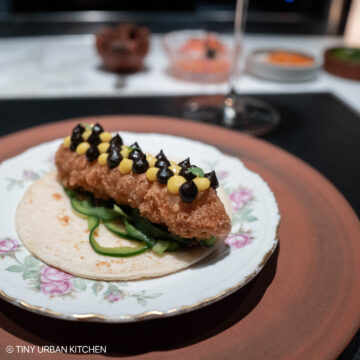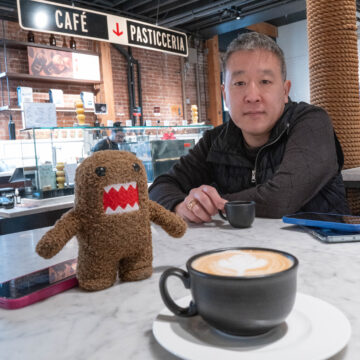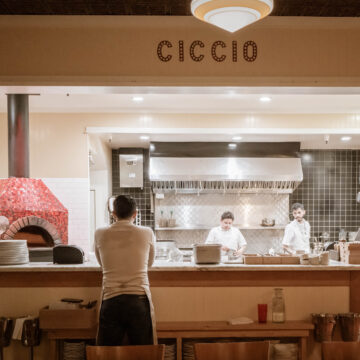
This is part 3 of the Los Angeles Eating Adventures Series. The other posts in this series include Peking Restaurant and Scoops Westside.
Could it be?
A sushi experience in the US that actually mirrors the experience I had in Japan?
From my many experiences eating sushi in Japan, I've come to the conclusion that sushi in Japan is nothing like sushi in the US. Although the sheer availability of fish in Japan has something to do with it, I've always noticed that the dining experience is different.
You can read my detailed thoughts about it here, but certain things are different in Japan. The sushi chefs don't let you put wasabi in your soy sauce; they instruct you whether to use soy sauce at all; and they hand you the pieces, one morsel at a time.
Imagine my curiosity when a good friend of mine told me, "we found a place in L.A. that serves sushi just like in Japan! Piece by piece, and they are really strict about wasabi!"
After finding out that this restaurant also had one of the highest Zagat ratings possible (29), along with one coveted Michelin star, I was more than just curious.
I really, really wanted to check this place out.
Sushi Zo sits in the unlikeliest of places. It's on the edge of a strip mall in Culver City. The interior decor is spartan, and the overall ambiance is very casual.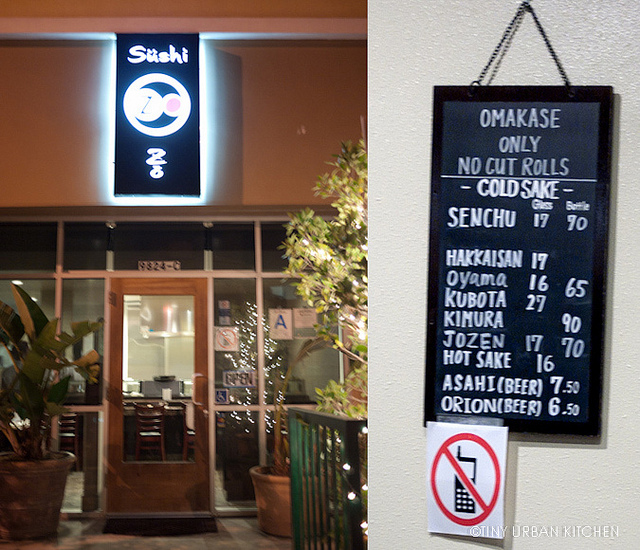
Maybe casual is not the right word, since the restaurant is not exactly the most relaxing atmosphere.
The chalkboard in front dictates that everything is omakase only. This means you do not order from a menu. Instead, the chef just chooses what he wants to serve you (taking into account any dietary restrictions that you tell him at the beginning). You tell him when you're full. The price is a mystery, although it usually ends up costing anywhere from $100-$150 per person.
Other seemingly strict rules include the no cell phone sign and a specific note that says they do not sell cut rolls (perhaps they've tired of the "can I get a California roll?" inquiry). The chef will be stern with you, instructing you whether you are allowed to add soy sauce or not to your sushi. Mixing wasabi paste in your soy sauce? Out of the question.
The last time Bryan went, he attempted to take a photo of his food, only to be told by the sushi chef - No Photos! As you will soon see below, this policy was not strictly enforced when I came, at least not until after my entire meal when I tried to snap a picture of the chefs. Then they yelled at me. Oops! I put away the camera after that.
A Story of Thirty Courses
I'm thrilled I was able to capture images of every single item to share with you. Here are my thoughts about each course. I've tried my best to match up the photos with the descriptions, which should go in order from left to right and then down.
Enjoy!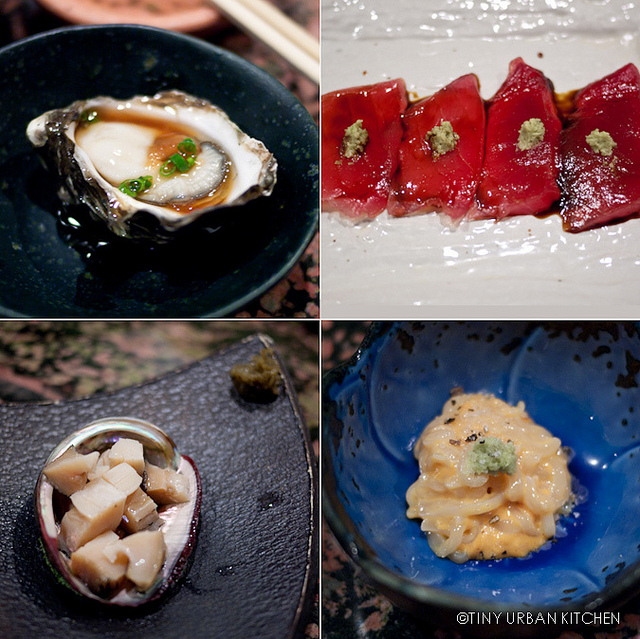
We started out with (1) Kumamoto Oyster. It was super sweet and fresh, with hints of lime. Next was what turned out to be the only traditional sashimi dish: (2) Maguro (Tuna) Sashimi with a dab of wasabi on top and soy sauce. The quality of this tuna was only average, and not as good as the tuna I've had in New York or Japan.
The third course (3) Abalone with Yuzu came in a shell and was quite interesting. It was hard, almost crunchy. Definitely exotic and interesting. (4) Sea Urchin with Squid was gorgeously creamy, sweet, yet salty at the same time. The squid was actually soft, like noodles. 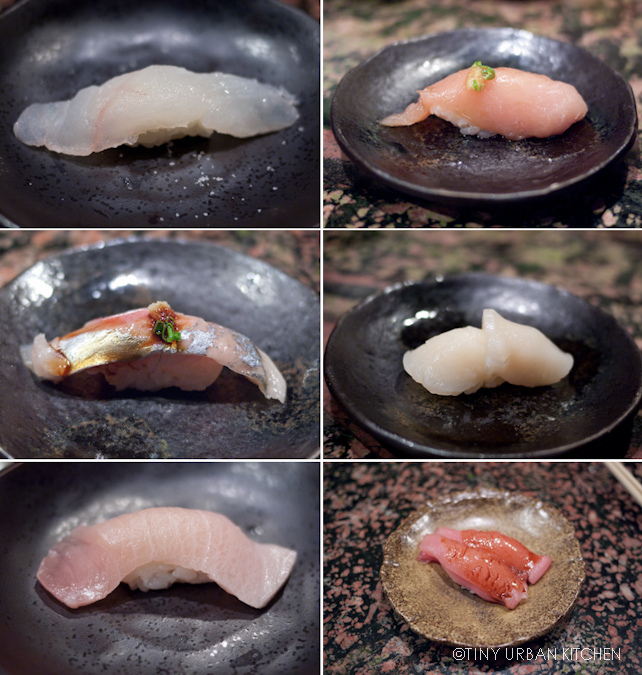
(5) Hirame (halibut) was a "no soy sauce" kind of dish (the chef told us not to add soy sauce!). Instead, he sprinkled some sea salt on top. The fish was a bit cold but the rice was warm (the way it should be). Overall, I found this one to be OK but not that exciting.
The (6) Albacore Tuna was the right temperature (not too cold like the previous one) and had a nice flavor accented by a dash of lime. I was surprised at how tiny the piece was - it was smaller than any piece of sushi I'd ever seen in any restaurant! I loved the (7) Mackerel, which was buttery, salty, and delicious.
The raw (8) Scallop was sweet, creamy, and had a strong wasabi essence -- a "yes soy sauce" dish. The (9) Yellowtail was solid, though again a bit smaller than I liked. The flavor was alright, but I've had better. (10) Chutoro (fatty tuna), one of my favorites in general, was creamy, flavorful, and the rice had excellent texture. The chef flavored this one for us by brushing on some sort of soy sauce.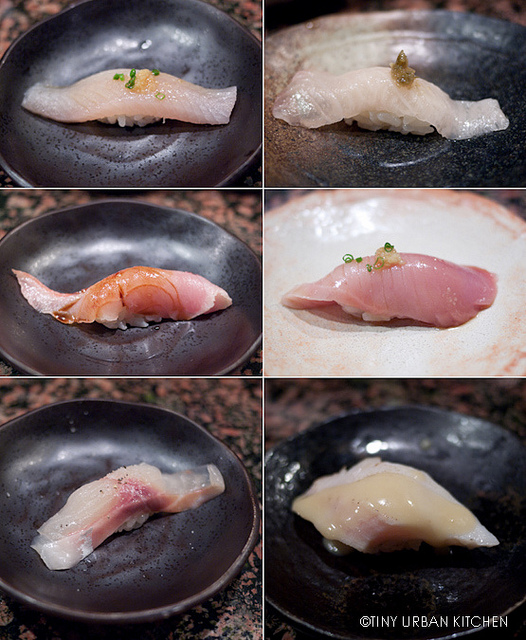
(11) Embodai (pompano), a mild, white fish, came with ponzu sauce.
(12) Kampachi came topped with a small dollop of yuzu kosho and was dense, slightly creamy, and quite tasty.
(13) Kimidai (golden eye snapper ) was OK, but the fish was just a bit cold compared to the warm rice.
(14) Skipjack Tuna was served with yuzu soy sauce and was absolutely delicious.
(15) Black Snapper with Truffle Salt was the perfect temperature and had pretty good rice texture. I absolutely loved the truffle salt on top. What a good idea!!
(16) Seared Black Cod with Miso Vinegar had a nice soft texture, although I didn't love the fish flavor. The sauce was creamy, (maybe mayonnaise based?) and pretty sweet.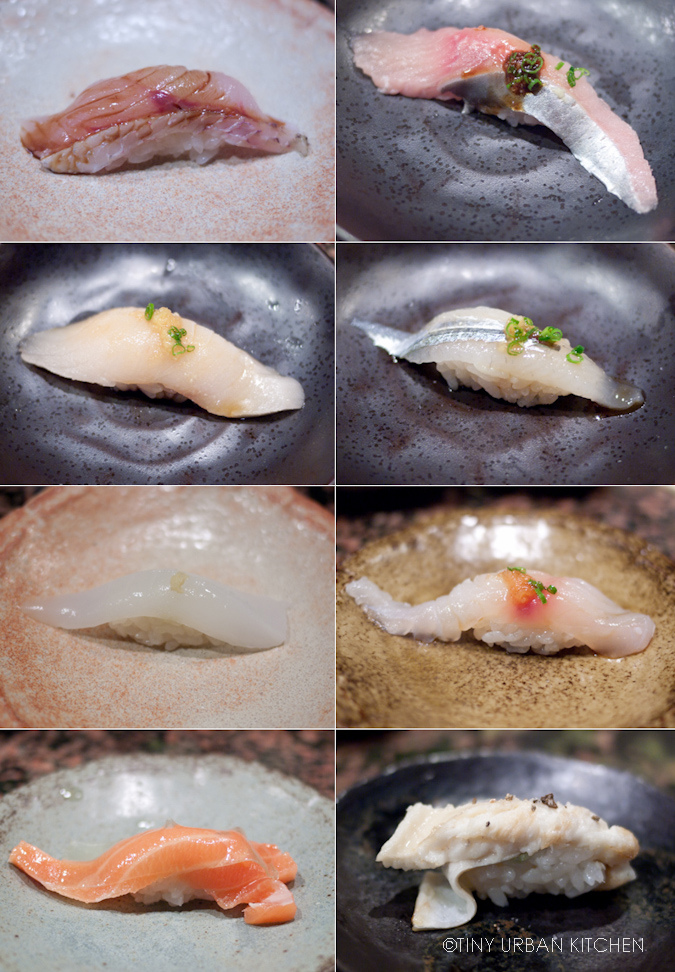
*Wow, if you're seriously still reading, I am impressed if you made it this far. I know, it's a long post, but there were so many courses!!!*
The (17) Yellow Striped Bass was a "meaty" fish and was slightly cold, but overall pretty good.
The (18) Sea Perch was kind of sweet, like scallops, and the accompanying rice had decent texture.
The (19) Orange Clam with Truffle Salt was a bit too salty and had a really strong wasabi component! The clam itself was nice and sweet, with a toothsome bite. I found the (20) Herring to be a bit chewy and less fatty than something like mackerel.
You often don't get good (25) Ika (squid) in the US, but this one was excellent, being slightly chewy yet still soft enough to enjoy.
The (26) Red Snapper, though slightly too cold, had a nice, soft texture and a good, clean flavor. The chef served it with ponzu sauce, salt and wasabi.
I loved (28) Anago (saltwater eel) when I was in Japan. Cooked with truffle salt, it was very soft, fatty, and flavorful. There was a nice combination of flavors from the vinegared rice and the sweet seaweed, though overall the anago was still not as good as those I've had in Japan.
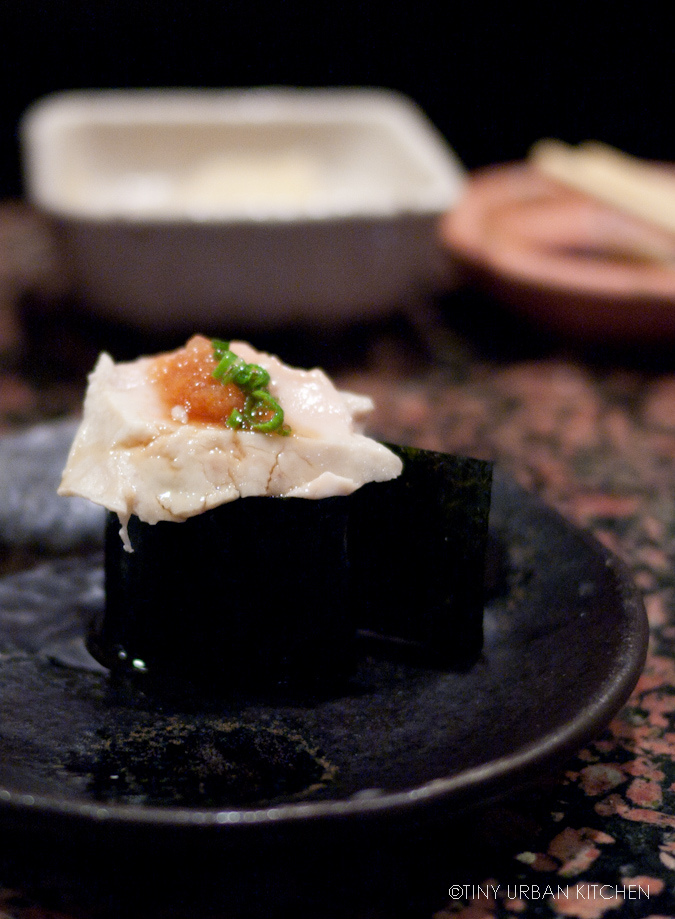
(23) Monkfish Liver was creamy, with a subtle liver taste but pretty strong seaweed flavors.
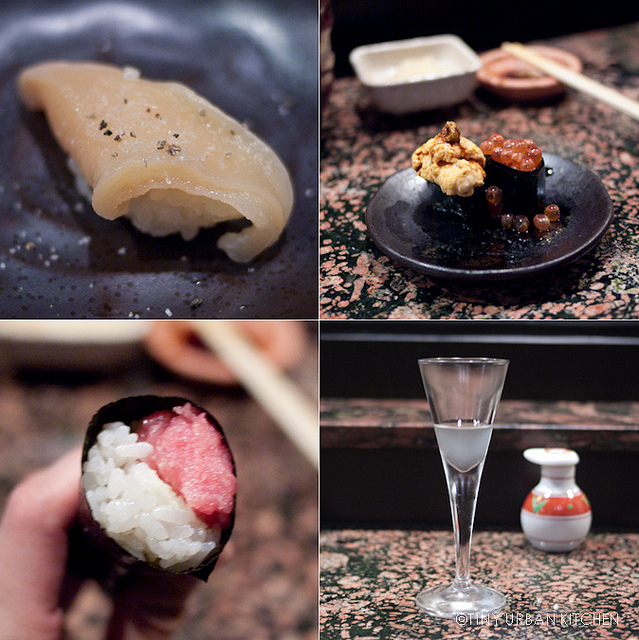
The (22) Mirugai (geoduck) was toothsome almost crunchy in texture and topped with lime and truffle salt.
The (29) Uni and Ikura (sea urchin and salmon roe) was actually very fresh and not stinky at all! The uni still wasn't as sweet as those you find in Japan. Nevertheless, it's among the best I've had Stateside.
Just like in Japan, you know your meal is coming to and end when you give you your (30) Toro Maki.
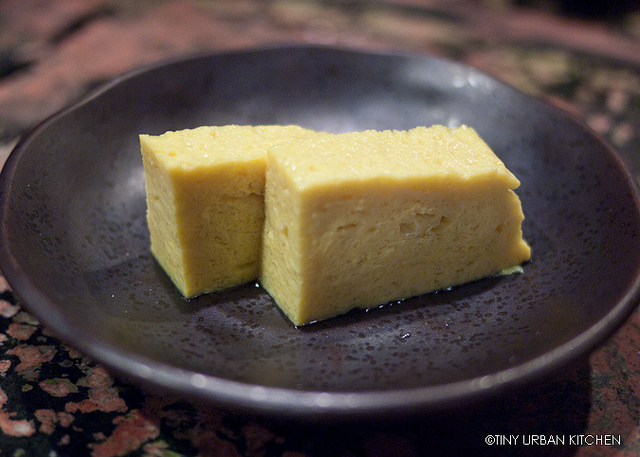
And then when the (31) Tamago (sweet egg) comes, you know it's over. This last piece is virtually like dessert.
Epilogue
Wow, that was a crazy long post. How often does one write up over thirty courses?
This is one of the closest dining experiences to Japan I've ever experienced in the US. From the strict rules about soy sauce to piece-by-piece way in which the sushi was served, many aspects of Sushi Zo remind me of Japan.
The variety and selection of seafood is excellent, and the overall quality is very good. In terms of execution, I found certain pieces to be perfect, while others were just a bit off (e.g., temperatures of the fish vs. the rice).
The omakase for our meal was predominantly nigiri sushi, with only a handful of non nigiri pieces in the beginning and the end. The nigiri pieces are the smallest I've ever seen served at a restaurant. It's hard to tell from the photos, but the rice underneath is about 1.5 inches long.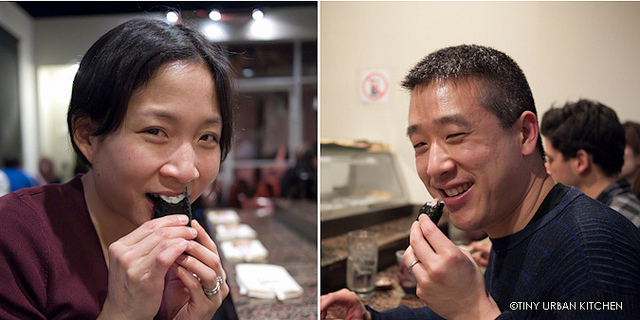
In some ways, having tiny pieces is fun because you get to try so many more pieces in one meal. Overall, however, I felt that it was harder to fully enjoy the optimal chewing and tasting experience for each nigiri piece because it was just a bit too small.
I'm really being pick at this point, though. Seriously, this is still one of the best and most authentic sushi places I've visited in the US (the other being my all time favorite, Sushi Yasuda in New York). I appreciate the vast selection of high quality seafood that they offer, and I love the authentic sushi bar experience where they hand you one piece at a time, each one individually custom-flavored.
I do wish they were a bit more flexible (e.g., letting you order something other than an omakase, letting you take pictures more often). However, it's cool that they offer such an authentic experience, and it's true that many of the top sushi restaurants in Japan operate this way.
The omakase ranges from $100-$200 depending on how many pieces you eat. You can probably get out for well under $100 during lunch. I can't quite remember, but I think our dinner was in the $150 range.
Sushi Zo
Culver City 9824
National Blvd Unit C
Los Angeles, CA 90034
All Rights Reserved

